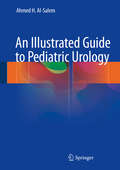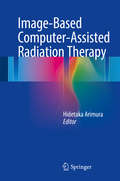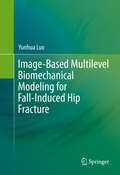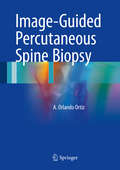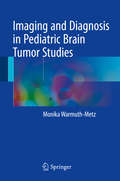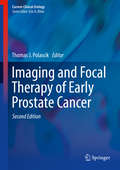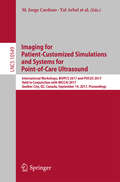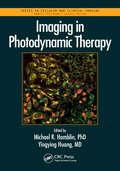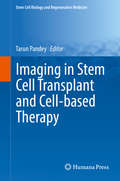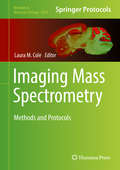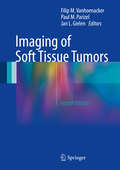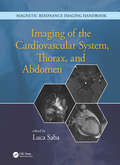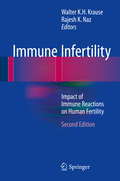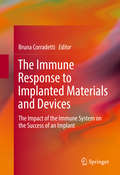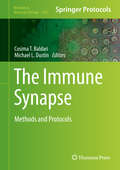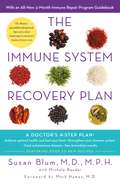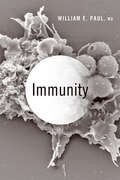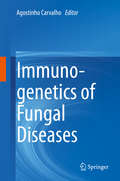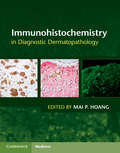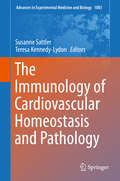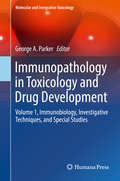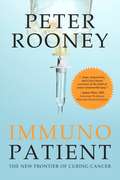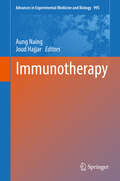- Table View
- List View
An Illustrated Guide to Pediatric Urology
by Ahmed H. Al-SalemThis book is vital for physicians caring for young patients with urological conditions, as a quick reference book that is easy to read and well-illustrated. Pediatric urological conditions are fairly common, and infants and children are seen on daily basis with urological problems either in clinics or in hospitals. This book is useful to general surgeons, pediatricians, pediatric surgeons, fellows, residents, general physicians and family physicians, medical students and nurses. The Editor has gained experience in the diagnosis and management of various urological problems in infants and children, working in busy hospital over the last 25 years.
Image-Based Computer-Assisted Radiation Therapy
by Hidetaka ArimuraThis book provides a comprehensive overview of the state-of-the-art computational intelligence research and technologies in computer-assisted radiation therapy based on image engineering. It also traces major technical advancements and research findings in the field of image-based computer-assisted radiation therapy. In high-precision radiation therapies, novel approaches in image engineering including computer graphics, image processing, pattern recognition, and computational anatomy play important roles in improving the accuracy of radiation therapy and assisting decision making by radiation oncology professionals, such as radiation oncologists, radiation technologists, and medical physicists, in each phase of radiation therapy. All the topics presented in this book broaden understanding of the modern medical technologies and systems for image-based computer-assisted radiation therapy. Therefore this volume will greatly benefit not only radiation oncologists and radiologists but also radiation technologists, professors in medical physics or engineering, and engineers involved in the development of products to utilize this advanced therapy.
Image-Based Multilevel Biomechanical Modeling for Fall-Induced Hip Fracture
by Yunhua LuoFall-induced hip fracture is an epidemic health risk among elderly people. This book presents an image-based multilevel modeling approach to understanding the biomechanics involved in fall-induced hip fracture. By hierarchically integrating a body-level dynamics model, a femur-level finite element model, and a local bone failure model, the biomechanics approach is able to simulate all stages in sideways falls and to incorporate all biomechanical variables affecting hip fracture. This book is useful for clinicians to accurately evaluate fracture risk, for biomechanical engineers to virtually test hip protective devices, and for biomedical students to learn image-based biomechanical modeling techniques. This book also covers: Biomechanical viewing on bone composition, bone remodeling, and bone strength Bone imaging and information captured for constructing biomechanical models Bone mechanical testing and mechanical properties required for biomechanical modeling
Image-Guided Percutaneous Spine Biopsy
by A. Orlando OrtizThis textbook covers key areas and reviews important principles and steps in the preparation for and the performance of spine biopsy. Image-guided percutaneous biopsy techniques and their application throughout the spinal axis are presented and discussed in detail. The advantages and disadvantages of various spine biopsy instruments are reviewed. Commonly encountered biopsy scenarios are considered in order to help readers effectively manage these situations when they occur in their practices. Clear guidance is offered on patient selection and preparation, which are critical to safe and effective outcomes, and much emphasis is placed on procedural safety, with a focus on complication avoidance and the appropriate reporting of complications. Image-Guided Percutaneous Spine Biopsy will be a welcome one-stop shop providing up-to-date information for all physicians with an interest in the subject, including radiologists, surgeons, and pathologists.
Imaging and Diagnosis in Pediatric Brain Tumor Studies
by Monika Warmuth-MetzThis book describes the features in structural imaging of the most important pediatric brain tumors with the aim of enabling radiologists to make the correct differential diagnosis and to provide the pediatric oncologist with all the imaging information relevant to further management. The opening chapter is devoted to the complex subject of pediatric trials at the national and international levels and the importance of staging for stratification, differential treatment, and outcome. A general imaging protocol for children with brain tumors is presented, and individual chapters then identify key points for the differential diagnosis and staging of posterior fossa tumors, low- and high-grade gliomas, germ cell tumors, and craniopharyngiomas. The relevance of aspects such as tumor site and age to diagnosis is explained, and pitfalls associated with meningeal dissemination and treatment-related complications mimicking recurrence are highlighted. The importance of ensuring comparability of follow-up by use of standard MR (or CT) imaging is emphasized. In drawing on the lessons gained both from pediatric trials and from the author's own experience, this book will be invaluable for all radiologists.
Imaging and Focal Therapy of Early Prostate Cancer
by Thomas J. PolascikThis text encompass an up-to-date, comprehensive review of the state-of-the-art for gland preserving therapies. Fully updated and revised, this text evaluates the scientific evidence for the evolving trend to treat intermediate risk, clinically localized prostate cancer in a focally ablative manner with novel gland-preserving, focal therapy methods. Various ablative devices such as high intensity focused ultrasound, irreversible electroporation, photodynamic therapy, cryotherapy and laser ablation, among others, is discussed in regard to their strengths and limitations as a therapeutic modality. Emphasis is placed on patient selection and outcomes utilizing both advanced imaging techniques and pathologic evaluation. Current and new approaches to image cancer foci within the prostate (multiparametric ultrasonography, multiparametric magnetic resonance image, etc) are presented along with various biopsy techniques, including robotics to map prostate cancer. Patient selection based on imaging and genomic classification, adjuvants to enhance therapy, treatment strategy, outcomes and patient centered concerns is discussed, providing an acceptable balance between cancer control and improved quality of life for patients. Written by experts in the field and lavishly illustrated with detailed line-art and photographs, Imaging and Focal Therapy of Early Prostate Cancer, Second Edition is designed as a comprehensive resource for urologists, radiation oncologists, medical oncologists, radiologists, uropathologists, molecular biologists, biomedical engineers, other clinicians -- residents, fellows, nurses and allied professionals -- and researchers with an interest in the diagnosis and novel treatment of prostate cancer. It will provide insight into the latest research and clinical applications of image-guided diagnosis and minimally invasive focal, gland-preserving treatment for prostate cancer.
Imaging for Patient-Customized Simulations and Systems for Point-of-Care Ultrasound: International Workshops, BIVPCS 2017 and POCUS 2017, Held in Conjunction with MICCAI 2017, Québec City, QC, Canada, September 14, 2017, Proceedings (Lecture Notes in Computer Science #10549)
by M. Jorge Cardoso, Tal Arbel, João Manuel R.S. Tavares, Stephen Aylward, Shuo Li, Emad Boctor, Gabor Fichtinger, Kevin Cleary, Bradley Freeman, Luv Kohli, Deborah Shipley Kane, Matt Oetgen and Sonja PujolThis book constitutes the refereed joint proceedings of the International Workshop on Bio-Imaging and Visualization for Patient-Customized Simulations, BIVPCS 2017, and the International Workshop on Point-of-Care Ultrasound, POCUS 2017, held in conjunction with the 20th International Conference on Medical Imaging and Computer-Assisted Intervention, MICCAI 2017, in Québec City, QC, Canada, in September 2017. The 12 full papers presented at BIVPCS 2017 and the 7 full papers presented at POCUS 2017 were carefully reviewed and selected. The papers feature research from complementary fields such as signal and image processing, mechanics, computational vision, mathematics, physics, informatics, computer graphics, bio-medical-practice, psychology and industry as well as ultrasound image systems applications.
Imaging in Photodynamic Therapy (Series in Cellular and Clinical Imaging)
by Michael R. Hamblin Yingying HuangThis book covers the broad field of cellular, molecular, preclinical, and clinical imaging either associated with or combined with photodynamic therapy (PDT). It showcases how this approach is used clinically for cancer, infections, and diseases characterized by unwanted tissue such as atherosclerosis or blindness. Because the photosensitizers are also fluorescent, the book also addresses various imaging systems such as confocal microscopy and small animal imaging systems, and highlights how they have been used to follow and optimize treatment, and to answer important mechanistic questions. Chapters also discuss how imaging has made important contributions to clinical outcomes in skin, bladder, and brain cancers, as well as in the development of theranostic agents for detection and treatment of disease. This book provides a resource for physicians and research scientists in cell biology, microscopy, optics, molecular imaging, oncology, and drug discovery.
Imaging in Stem Cell Transplant and Cell-based Therapy
by Tarun PandeyThis book provides a review of imaging techniques and applications in stem cell transplantation and other cell-based therapies. The basis of different molecular imaging techniques is explained in detail, as is the current state of interventional radiology techniques. While the whole is a comprehensive discussion, each chapter is self-sufficient enough so that each can be reviewed independently. The contributors represent years of international and cross-disciplinary expertise and perspective and are all well known in their fields. comprehensive information on the role of clinical and molecular imaging in stem cell therapy from this book reviewed in detail. Essential reading for radiologists and physicians who are interested in developing a basic understanding of stem cell imaging and applications of stem cells and cell based therapies. However, it will also be of interest to clinical scientists and researchers alike, including those involved in stem cell labeling, tracking & imaging, cancer therapy, angiogenesis and cardiac regeneration.
Imaging Mass Spectrometry: Methods and Protocols (Methods in Molecular Biology #1618)
by Laura M. ColeThis volume addresses the various techniques and novel applications of mass spectrometry imaging (MSI) and its role as a discovery tool in the field of proteomics, lipidomics, and metabolomics. The chapters in this book demonstrate how MSI can be applied to many areas of research such as clinical pathology, translational medicine, toxicology, biomarkers and response studies, and potential incorporation of MSI into forensic workflows. Written in the highly successful Methods in Molecular Biology series format, chapters include introductions to their respective topics, lists of the necessary materials and reagents, step-by-step, readily reproducible laboratory protocols, and tips on troubleshooting and avoiding known pitfalls. Innovative and comprehensive, Imaging Mass Spectrometry: Methods and Protocols is a valuable resource for research scientists and clinicians who are interested in further studies of MSI technologies.
Imaging of Soft Tissue Tumors
by Filip M. Vanhoenacker Paul M. Parizel Jan L. GielenThis richly illustrated book, in an extensively revised new edition, provides a comprehensive survey of the role of medical imaging studies in the detection, staging, grading, tissue characterization, and post-treatment follow-up of soft tissue tumors. The indications for and relative merits of various imaging modalities are fully described, with particular emphasis on the role of advanced MRI techniques that can improve diagnostic accuracy and evaluation of treatment response. The most recent version of the WHO Classification of Soft Tissue Tumors is introduced, and individual chapters are devoted to imaging of each of the tumor groups in that classification as well as other soft tissue masses. Numerous new illustrations of both common and rare tumors are included, providing a rich pictorial database of soft tissue masses. In addition, imaging findings are correlated with clinical, epidemiologic, and histologic data. Imaging of Soft Tissue Tumors will be of value in daily practice not only for radiologists but also for orthopedic surgeons, oncologists, and pathologists.
Imaging of the Cardiovascular System, Thorax, and Abdomen
by Luca SabaMagnetic resonance imaging (MRI) is a technique used in biomedical imaging and radiology to visualize internal structures of the body. Because MRI provides excellent contrast between different soft tissues, the technique is especially useful for diagnostic imaging of the brain, muscles, and heart. <P><P>In the past 20 years, MRI technology has improved significantly with the introduction of systems up to 7 Tesla (7 T) and with the development of numerous post-processing algorithms such as diffusion tensor imaging (DTI), functional MRI (fMRI), and spectroscopic imaging. From these developments, the diagnostic potentialities of MRI have improved impressively with an exceptional spatial resolution and the possibility of analyzing the morphology and function of several kinds of pathology. <P><P>Given these exciting developments, the Magnetic Resonance Imaging Handbook: Imaging of the Cardiovascular System, Thorax, and Abdomen is a timely addition to the growing body of literature in the field. Offering comprehensive coverage of cutting-edge imaging modalities, this book: <Li>Discusses MRI of the heart, blood vessels, lungs, breasts, diaphragm, liver, gallbladder, spleen, pancreas, adrenal glands, and gastrointestinal tract <Li>Explains how MRI can be used in vascular, posttraumatic, postsurgical, and computer-aided diagnostic (CAD) applications <Li>Highlights each organ’s anatomy and pathological processes with high-quality images <Li>Examines the protocols and potentialities of advanced MRI scanners such as 7 T systems <Li>Includes extensive references at the end of each chapter to enhance further study <P><P>Thus, the Magnetic Resonance Imaging Handbook: Imaging of the Cardiovascular System, Thorax, and Abdomen provides radiologists and imaging specialists with a valuable, state-of-the-art reference on MRI.
Immune Infertility
by Walter K.H. Krause Rajesh K. NazThis book offers comprehensive coverage of both basic and clinical aspects of immune reactions responsible for infertility. It has four sections focusing on Sperm antigens, Antisperm antibodies (ASAs), Clinical impact of ASAs, and Immune contraception, and include contributions from leading experts in these fields. This new edition of the book offers a comprehensive update that reflects the very significant advances in reproductive immunology that have been achieved over the past five years, especially related to the sperm proteome, sperm-egg binding/fusion proteins, gene knockout studies, and immunocontraception. Reproductive immunology continues to be a fast-growing discipline in which new knowledge is emerging almost every day. Immune Infertility is a model source of vital and reliable information on the latest scientific developments in the field. It will be of value for clinicians, scientists, students, residents, and fellows working in reproductive biology, obstetrics and gynecology, and urology.
The Immune Response to Implanted Materials and Devices
by Bruna CorradettiThis book provides a comprehensive overview of the cascade of events activated in the body following the implant of biomaterials and devices. It is one of the first books to shed light on the role of the host immune response on therapeutic efficacy, and reviews the state-of-the-art for both basic science and medical applications. The text examines advantages and disadvantages of the use of synthetic versus natural biomaterials. Particular emphasis is placed on the role of biomimicry in the development of smart strategies able to modulate infiltrating immune cells, thus reducing side effects (such as acute and chronic inflammation, fibrosis and/or implant rejection) and improving the therapeutic outcome (healing, tissue restoration). Current cutting-edge approaches in tissue engineering, regenerative medicine, and nanomedicine offer the latest insights into the role immunomodulation in improving tolerance during tissue transplant in the treatment of orthopaedic, pancreatic, and hepatic diseases. "Immune Response to Implanted Materials and Devices" is intended for an audience of graduate students and professional researchers in both academia and industry interested in the development of smart strategies, which are able to exploit the self-healing properties of the body and achieve functional tissue restoration.
The Immune Synapse
by Michael L. Dustin Cosima T. BaldariThis volume provides all the essential protocols that are currently used to study the immune synapse. Chapters in The Immune Synapse: Methods and Protocols cover methods for the study of the dynamics of immune synapse assembly, traffic at the immune synapse, new high resolution imaging, biophysical and computational methods for the study of the immune synapse, effector immune synapses, B cell, NK and mast cell immune synapses, and immune interactions in vivo. Written in the highly successful Methods in Molecular Biology series format, chapters include introductions to their respective topics, lists of the necessary materials and reagents, step-by-step, readily reproducible laboratory protocols, and tips on troubleshooting and avoiding known pitfalls. Authoritative and practical, The Immune Synapse: Methods and Protocols will be of interest to immunologists and, at a more general level, to cell biologists, biophysicists and computational biologists.
The Immune System Recovery Plan: A Doctor's 4-Step Program to Treat Autoimmune Disease
by Dr Susan Blum M.D., M.P.H"The Immune System Recovery Plan is the right book, at the right time, by the right person. We are witnessing a significant increase in autoimmune inflammatory diseases, which include more than 80 different diagnoses. Dr. Blum has done a magnificent job helping the reader to understand how this family of inflammatory disorders, including arthritis and fibromyalgia, can be managed with the diet and lifestyle program she developed in her practice. Her step-by-step approach is based on her considerable years of experience as a physician, and the emerging medical science that, for the first time, has developed an understanding of how genetics, lifestyle and nutrition play a role in origin of these disorders. The approach described in Dr. Blum's book represents the leading edge in the lifestyle management of chronic inflammatory disorders. It is a 'news to use' book that provides real assistance to those with inflammatory disorders who are looking for a clinically sensible approach to their problems." (Jeffrey Bland, Ph.D., FACN, President, Personalized Lifestyle Medicine Institute)The innovative four-step method in this book focuses on:Using food as medicineUnderstanding the stress connectionHealing your gut and digestive systemOptimizing liver functionEach of these sections includes an interactive workbook to help you determine and create your own personal treatment program. Also included are recipes for simple, easy-to-prepare dishes to jump-start the healing process.The Immune System Recovery Plan is a revolutionary way for people to balance their immune systems, transform their health, and live fuller, happier lives.
Immunity: Innate Immunity (Advances In Experimental Medicine And Biology Ser. #560)
by William E. PaulA leading figure in immunology takes readers inside the remarkably powerful human immune system.Winner of the CHOICE Outstanding Academic Title of the Choice ACRLThe immune system has incredible power to protect us from the ravages of infection. Boosted by vaccines, it can protect us from diseases such as measles. However, the power of the immune system is a double-edged sword: an overactive immune system can wreak havoc, destroying normal tissue and causing diseases such as type I diabetes, rheumatoid arthritis, and multiple sclerosis. The consequences of an impaired immune system, on the other hand, are all too evident in the agonies of AIDS.Packed with illustrations, stories from Dr. William E. Paul’s distinguished career, and fascinating accounts of scientific discovery, Immunity presents the three laws of the human immune system—universality, tolerance, and appropriateness—and explains how the system both protects and harms us. From the tale of how smallpox was overcome and the lessons of the Ebola epidemic to the hope that the immune system can be used to treat or prevent cancer, Dr. Paul argues that we must take advantage of cutting-edge technologies and promising new tools in immunological research.
Immunogenetics of Fungal Diseases
by Agostinho CarvalhoThis book provides up-to-date information on immunogenetics of fungal diseases in the context of primary and acquired immunodeficiencies. Different aspects of this emerging field are covered, including epidemiology of fungal diseases, innate and adaptive antifungal immunity, and the role of immunogenetics in defining susceptibility to fungal diseases in primary (CMC, CGD, etc. ) immunodeficiencies and hematologic patients. The available information will also be discussed in the scope of new biomarker discovery and development of immunotherapeutic approaches for personalized diagnostics and therapy. The book addresses Professors, researchers and advanced students of Medicine, Immunology, Microbiology and Genetics.
Immunohistochemistry in Diagnostic Dermatopathology
by Hoang Mai P.Rapid and cost-effective immunohistochemistry plays a crucial role in diagnostic pathology. However there are currently very few textbooks dedicated to its role, especially in diagnostic dermatopathology. This comprehensive volume provides a practical guide to the application of immunohistochemistry in dermatopathology and bridges the knowledge gap by updating readers with helpful diagnostic immunostains as well as recently available ones. Organized by lines of differentiation, each chapter includes a synopsis of applicable antibodies, pertinent immunohistochemical panels, summary tables outlining the staining patterns of the entities in the differential diagnosis, and case studies. The twelve chapters cover entities based on lineage including epithelial, melanocytic, lymphoid, adnexal and soft tissue. The role of immunohistochemistry as a screening test for underlying genetic syndromes, immunobullous diseases, detection of infectious agents and therapeutic purpose is also discussed in detail. This is an essential text for pathologists, dermatopathologists and residents in pathology and dermatology.
The Immunology of Cardiovascular Homeostasis and Pathology
by Susanne Sattler Teresa Kennedy-LydonCardiovascular immunology is a newly emerging research area, investigating the crosstalk between the cardiovascular and the immune system. This crosstalk is evident through (1) crucial immunological capacities and functions of cardiovascular cell types, including cardiomyocytes, fibroblasts, endothelial cells, pericytes and cardiac resident macrophages, (2) the impact of aberrant immune function on the development of cardiovascular disease such as atherosclerosis, direct and indirect immune-mediated heart disease and vasculitis, and (3) the crucial role of the immune system in cardiac repair and regeneration. The Immunology of Cardiovascular Homeostasis and Pathology covers all these aspects of cardiovascular immunology, starting with homeostatic immunological functions of traditional cardiovascular cell types, and moving then to the role of the immune system in cardiovascular pathology and to recent research into targeting the immune system to boost cardiac healing and regeneration.
Immunopathology in Toxicology and Drug Development
by George A. ParkerThis book provides a fundamental understanding of immunopathology and immunopathologic processes, with particular attention to nonclinical toxicology studies. Chapters provide organ system-based summaries of spontaneous pathology and common responses to xenobiotics. A companion volume, Immunopathology in Toxicology and Drug Development: Volume 1, Immunobiology, Investigative Techniques, and Special Studies, offers an overview of general immunobiology, cells of the immune system, signaling and effector molecules, and immunopathology assays. These informative and strategic books were created in response to the large segment of drug development that focuses on chronic diseases, many of which involve alterations to the immune system. Therapies that target these diseases commonly involve some form of immunomodulation. As a result, the two volumes of Immunopathology in Toxicology and Drug Development are critical texts for individuals involved in diverse aspects of drug development. Readers will acquire a thorough understanding of immunopathology for detection and accurate interpretation of pathologic effects of xenobiotics on the immune system.
Immunopathology in Toxicology and Drug Development
by George A. ParkerThis book provides a fundamental understanding of immunopathology and immunopathologic processes, with particular attention to nonclinical toxicology studies. Chapters provide an overview of general immunobiology, cells of the immune system, signaling and effector molecules, and immunopathology assays. A companion volume, Immunopathology in Toxicology and Drug Development: Volume 2, Organ Systems, offers summaries of organ-specific immunobiology and immunopathology as well as common responses to xenobiotics. These informative and strategic books were created in response to the large segment of drug development that focuses on chronic diseases, many of which involve alterations to the immune system. Therapies that target these diseases commonly involve some form of immunomodulation. As a result, the two volumes of Immunopathology in Toxicology and Drug Development are critical texts for individuals involved in diverse aspects of drug development. Readers will acquire a thorough understanding of immunopathology for detection and accurate interpretation of pathologic effects of xenobiotics on the immune system.
Immunopatient: The New Frontier of Curing Cancer
by Peter RooneyWhen an X-ray of a sore arm quickly leads to a diagnosis of Stage IV kidney cancer—one which would soon affect his bones, his lungs, lymph nodes, and brain—Peter Rooney’s life will never be the same. Faced with the prognosis of an incurable disease and armed only with the will to fight back, Immunopatient chronicles Peter’s desperate quest for hope and healing, and the experimental treatment that will give him a chance to strike back at his disease. Detailing both the medical breakthroughs that provided Peter with cutting-edge treatment and his inspirational quest to conquer both his fear and his illness through mindfulness and positive visualization, Immunopatient is a gripping memoir, one that offers new hope to cancer patients everywhere to never give up looking for answers. Peter’s story, both humble and human, showcases the heights of medical science and the depths of human endurance, proving that anything is possible as long as you keep moving forward.
Immunotherapy
by Aung Naing Joud HajjarIn the last decade, immunotherapy has revolutionized the practice of medicine in the field of oncology. This book, Immunotherapy, highlights the immunotherapeutic approaches currently in use and strategies to overcome the associated challenges. As comprehensive knowledge of basic immunology in the context of tumor biology is required to move further along the line of development in translational science, this book provides an overview of the cellular components of the immune system that interact with each other to provide a successful immune response. Immunotherapy offers promising antitumor activity across multiple cancer types as it does not attack the tumor but primarily revitalizes a suppressed immune system. It is beyond the scope of this book to discuss the immunotherapeutic approaches across the tumor board. However, the book features the role of immune-oncology in acute myeloid leukemia, non-small cell lung cancer, and sarcomas to showcase the recent advances in the management of cancer broadly classified as hematological malignancies, solid tumors, and tumors arising in the connective tissue. The book also discusses alternative formulations and combinatorial approaches to enhance the therapeutic index of these agents. As immunotherapeutic agents differ significantly from chemotherapeutic agents in response patterns and toxicity profiles, evaluating their safety and efficacy in clinical trials remains a challenge. In this book, we discuss the use of a variety of traditional and new immunotherapy criteria to evaluate response, their inadequacies, and clinical implications. The book also outlines how recent advances in medical imaging technology have the potential to provide high-dimensional data to improve decision support and individualize treatment selection and monitoring. Importantly, the book attempts to increase the awareness to immune related adverse events and the need for aggressive and judicious management of toxicities to improve treatment outcomes in patients on immunotherapy In short, this book provides a broad understanding of immunotherapy and ways to leverage the immune system to make inroads in the fight against cancer.
Immunotherapy (Advances in Experimental Medicine and Biology #995)
by Aung Naing and Joud HajjarIn the last decade, immunotherapy has revolutionized the practice of medicine in the field of oncology. This book, Immunotherapy, highlights the immunotherapeutic approaches currently in use and strategies to overcome the associated challenges. As comprehensive knowledge of basic immunology in the context of tumor biology is required to move further along the line of development in translational science, this book provides an overview of the cellular components of the immune system that interact with each other to provide a successful immune response.Immunotherapy offers promising antitumor activity across multiple cancer types as it does not attack the tumor but primarily revitalizes a suppressed immune system. It is beyond the scope of this book to discuss the immunotherapeutic approaches across the tumor board. However, the book features the role of immune-oncology in acute myeloid leukemia, non-small cell lung cancer, and sarcomas to showcase the recent advances in the management of cancer broadly classified as hematological malignancies, solid tumors, and tumors arising in the connective tissue. The book also discusses alternative formulations and combinatorial approaches to enhance the therapeutic index of these agents.As immunotherapeutic agents differ significantly from chemotherapeutic agents in response patterns and toxicity profiles, evaluating their safety and efficacy in clinical trials remains a challenge. In this book, we discuss the use of a variety of traditional and new immunotherapy criteria to evaluate response, their inadequacies, and clinical implications. The book also outlines how recent advances in medical imaging technology have the potential to provide high-dimensional data to improve decision support and individualize treatment selection and monitoring. Importantly, the book attempts to increase the awareness to immune related adverse events and the need for aggressive and judicious management of toxicities to improve treatment outcomes in patients on immunotherapy In short, this book provides a broad understanding of immunotherapy and ways to leverage the immune system to make inroads in the fight against cancer.
